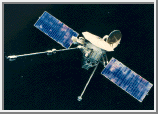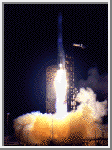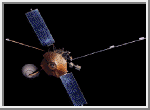
Courtesy of NASA's National Space Science Data Center
Mariner 10 was the seventh successful launch in the Mariner spacecraft series, and the first to use the gravitational pull of one planet (Venus) to reach another (Mercury). Instruments on board the spacecraft were designed to measure the atmospheric, surface, and physical characteristics of Mercury and Venus. Experiments included television photography, magnetic field, plasma, infrared radiometry, ultraviolet spectroscopy, and radio science detectors. An experimental X-band, high-frequency transmitter was flown for the first time on the spacecraft.
On November 3, 1973, Mariner 10 was placed in a parking orbit after launch for approximately 25 minutes, then placed in orbit around the Sun en route to Venus. The orbit direction around the Sun was opposite to that of the Earth. Mariner 10 flew past Venus on February 5, 1974, at a distance of 4,200 kilometers (2,610 miles). More than 4,000 photos of Venus revealed a nearly round planet enveloped in smooth cloud layers. Venus exhibited a slow rotational period of 243 days and had only 0.05 percent of Earth's magnetic field. The planet's atmosphere was composed mostly of carbon dioxide.
After the Venus flyby, Mariner's trajectory was bent in toward the Sun to accelerate and fling it out of Venus's gravitational field and onward to Mercury. Mariner 10 reached Mercury on March 29, 1974, passing over the planet at 705 kilometers (438 miles) above the surface. A second encounter with Mercury occurred on September 21, 1974, at an altitude of about 47,000 kilometers (29,200 miles). The sunlit side of the planet and the south polar region were photographed. A third and last Mercury encounter, at an altitude of 327 kilometers (203 miles), occurred on March 16, 1975. About 300 additional photographs were obtained along with magnetic field measurements. Photographs of the planet reveal an intensely cratered, Moon-like surface and a faint atmosphere of mostly helium, resulting from solar wind bombardment. Engineering tests were continued until March 24, 1975, when the supply of attitude-control gas was depleted and the mission was terminated.
The Mariner 10 Spacecraft
The Mariner 10 spacecraft weighed 503 kilograms (1,108 pounds), including 29 kilograms (64 pounds) of fuel and 30 kilograms (66 pounds) associated with the adapter between the spacecraft and the Centaur upper stage launch vehicle. Its body was an eight-sided framework with eight electronics compartments. It measured 1.39 meters (4.56 feet) diagonally and 0.457 meters (1.5 feet) in depth. Two solar panels, each 2.7 meters (8.86 feet) long and 0.97 meters (3.18 feet) wide, were attached at the top, supporting 5.1 square meters (55 square feet) of solar cell area. The rocket engine was liquid-fueled, with two sets of reaction jets used to stabilize the spacecraft on three axes. It carried a low-gain omnidirectional antenna, composed of a honeycomb-disk parabolic reflector, 1.37 meters (4.5 feet) in diameter, with focal length 55 centimeters (1.8 feet). Feeds enabled the spacecraft to transmit at S- and X-band frequencies. The spacecraft carried a Canopus star tracker, located on the upper ring structure of the octagonal satellite, and acquisition sun sensors on the tips of the solar panels. The interior of the spacecraft was insulated with multilayer thermal blankets at top and bottom. A sunshade was deployed after launch to protect the spacecraft on the solar-oriented side.
 Assembly
Assembly
Here the Mariner 10 spacecraft is being assembled prior to its November
1973 launch. During its two-year mission, the spacecraft transmitted
more than 12,000 images of Mercury and Venus. The mission ended in March
1975. Mariner 10 is still orbiting the sun, even though its electronic
systems have probably been destroyed by solar radiation.
(Courtesy NASA/JPL)
 Liftoff
Liftoff
A nighttime lift-off of the Atlas Centaur launch vehicle propelled
Mariner 10 on its historic mission to Venus and Mercury.
(Courtesy NASA/JPL)
 Two Firsts
Two Firsts
This model of Mariner 10 shows the spacecraft as it appeared during
flight. The Mariner 10 mission required more course corrections than
any previous mission and was the first spacecraft to use the
gravitational pull of one planet to help it reach another planet. This
craft was also the first to use the solar wind as a means of
locomotion; when the probe's thruster fuel ran low, scientists used the
solar panels as sails to make course corrections.
(Courtesy NASA/JPL)
 Venus/Mercury Mission
Venus/Mercury Mission
Mariner 10, shown in this artist's rendering, was the last in a series
of Mariner missions designed to survey other planets in the solar
system. Launched in November 1973, this mission provided new
information about Mercury and Venus in the Mariner program's first
dual-planet mission.
(Courtesy NASA/JPL)

 Space History
Space History